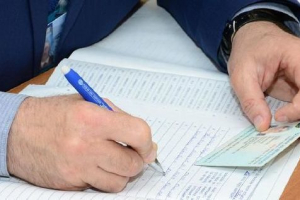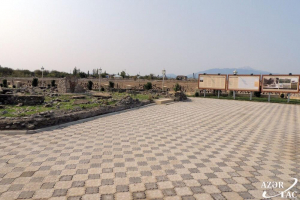


Designated as World Refugee Day in 2000 by the UN to commemorate the 50th anniversary of the passing of the 1951 UN Convention relating to the Status of Refugees, 20 June is acknowledged across the world as the day to remember the dispossessed, those unfortunate victims of conflict and war across the world. At present, refugees from such conflicts in Syria and Ukraine, and the subsequent pan-European migration crisis, have come in to stark focus. However, one casualty is that the hierarchy of news importance often results in longstanding tragedies being overlooked, particularly if they were inadequately reported at the time.
One example of this was the Armenian–Azerbaijani conflict over Nagorno-Karabakh, which raged from 1988–94 during and just after the collapse of the Soviet Union. This resulted in the illegal Armenian occupation of approximately 20 per cent of Azerbaijani territory, leading an estimated one million Azerbaijanis to become refugees and internally displaced persons (IDPs). This equates to 10 per cent of the population, representing one of the highest levels of displacement per capita in the world.
Initially living in extremely challenging conditions, the Azerbaijani government has done much to rehouse the affected populations so they have access to the basics of life – clean water, sanitation, adequate food and educational facilities are now available to the two generations of children who have never seen their homeland. However, all maintain a fervent desire to return to their native lands.
This humanitarian crisis led American photographer Ed Kashi, whose work has been published by Newsweek, The New York Times Magazine, Time and the National Geographic, to turn his socially-aware lens to the IDP camps. Recognising that it was impossible to capture the full enormity of the crisis, he decided to just focus on a few vignettes of everyday life in the camps in western Azerbaijan. These include children playing football, wearing replica shirts emblazoned with the names of their Manchester United heroes; a father and daughter – both of whom lost loved ones in the war ¬– cooking together; and a mother holding the photo of her dead child, killed by an Armenian sniper’s bullet along the ‘contact line’ between Azerbaijan and the Armenian-occupied territories. All photographs emphasised the common humanity that we all share, regardless of culture or religion.
Entitled Unresolved Dreams: Azerbaijan’s Refugees and Internally Displaced Persons, this poignant exhibition was hosted at the Press Club Brussels Europe, located in the heart of the diplomatic quarter and in the shadow of the European Parliament, before an audience of pan-European journalists. It was organised by the Benelux branch of The European Azerbaijan Society (TEAS) and supported by the VII Photo Agency.
Speaking against a backdrop of photos and footage taken during the shoot, edited by Julie Winokur, Ed explained: “My family fled Iraq during the 1940s, so we know the tragedy of displacement. Unfortunately, the refugee/IDP issue has affected a seemingly endless number of countries, but the reasons for these issues are often underreported. The populations involved often feel lost and hopeless. They all want to return home.
“My intention in taking these photos was to help viewers see behind the statistics and realise that the issue needs to be resolved. Many of the people in the photos are suffering health problems due to their conditions. They were affluent back in Nagorno-Karabakh, and their lives have been impacted severely.”
Marc Verwilghen, Director, TEAS Benelux, commented: “According to the most recent statistics from the UNHCR, the number of refugees and IDPs worldwide is constantly increasing, now equating to almost 66m people.
“We cannot consider this problem as a ‘far from our bed show’… even in our Belgian history, we remember the phenomenon of the refugees during both World Wars.
“Today, TEAS Benelux is bringing to your attention the fate of the almost one million Azerbaijanis, who fled their homes and lands due to the Armenian–Azerbaijani conflict over Nagorno-Karabakh.
“Despite the passing of four UN Security Council resolutions, one UN General Assembly resolution and rulings by the European Court of Human Rights (ECHR) in Strasbourg and the Parliamentary Assembly of the Council of Europe (PACE) condemning Armenia, nothing has changed for over 20 years.
“Armenia continues to resist accepting responsibility for its actions over Nagorno-Karabakh. As a former Minister of Justice, I acknowledge that Azerbaijan is on the correct side of international law. Azerbaijan is a direct neighbour to the EU, and it needs to play its part in resolving this issue.”
H.E. Fuad Isgandarov, Azerbaijani Ambassador to Belgium, Luxembourg and the EU, commented: “Refugees are all around us – even in the streets of Brussels – and the concept of the refugee is very familiar to all of us. These are exceptional photographs, and I personally knew many of the people photographed by Ed Kashi in the camps before I entered the diplomatic service. It must be remembered these Azerbaijani IDPs are representatives of European civilisation, and that the conflict that caused them to become IDPs happened over 25 years ago. Many of them became IDPs when they were very young, but they still want to return home. Azerbaijanis – as a nation – have a very strong attachment to their homeland.
“My hope is that such as events as today will enhance understanding of the issues, and that a swift solution to the conflict, and the plight of these people, needs to be found.”
Amanda Paul, Senior Policy Analyst, European Policy Centre (EPC), stated: “This is a sad and sensitive topic. Azerbaijan is home to the second largest IDP population per capita in the world. My second family – from Azerbaijan – is from Kalbajar – and they were forced to flee during the war. Every day, their thoughts are focused on Kalbajar, including that of the matriarch of the family, who will probably never return.
“The victims are just ordinary people, like you and me. Displacement is the great problem of our age, but the South Caucasus – including Georgia – has a disproportionately large number. I would like to remind you of the case of Chiragov and others vs. Armenia, where the ECHR resoundingly condemned Armenia. Furthermore, the occupying Armenians have deliberately destroyed houses and infrastructure.
“We need a new format for the peace process, and need to make serious steps towards this, beginning with the return with some of the occupied territories.”
The presentation ended with a lively and informed question-and-answer session covering such areas as the impact of assimilation on IDP children who have never seen their homeland; new strategies for diplomatic conflict resolution; and Ed Kashi’s journalistic reasons for focusing on IDP children and youths in the exhibition.














